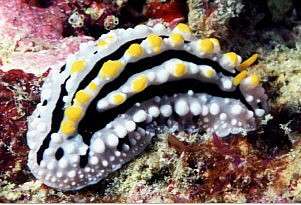
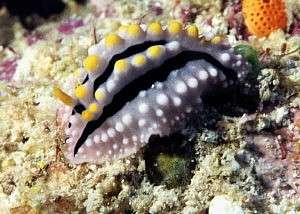
Phyllidia alyta
Yonow, 1996
Order: NUDIBRANCHIA
Suborder: DORIDINA
Superfamily: EUDORIDOIDEA
Family: Phyllidiidae
DISTRIBUTION
Western Indian Ocean - known from Maldives and Mauritius.
PHOTO
Maldive Islands. UPPER: 44 mm long, depth 14 m, Bandos Is., divesite "Banana Reef", Oct. 28, 1999
LOWER: 34 mm long, depth 12 m, Olhahali Is., divesite "The Wall", Oct. 31, 1999. PHOTOS: Erwin Koehler.
This species is characterised by four longitudinal black bands which rarely meet. The inner pair run from behind the rhinophores to just in front of the anal papilla. Between them is the median row of tubercles which are usually tipped with orange/yellow. There is then a second row of tubercles on each side which are rarely tipped in yellow/orange. Outside this row is the second black line on each side which runs from the anterior edge of the mantle back to behind the anal papilla. The there is also usually a black tranverse band between the rhinophores. Outside the longitudinal black lines are another row of tubercles and outside that row samll irregularly scattered tubercles at the mantle edge. There is a solid black median line on the sole of the foot which is broken anteriorly into one or two patches. The rhinophores are yellow.
Reference:
• Yonow, N., (1996) Systematic Revision of the Family Phyllidiidae in the Indian Ocean Province: Part 1 (Opisthobranchia: Nudibranchia: Doridoidea). Journal of Conchology, 35: 483-516.
Rudman, W.B., 1999 (November 23) Phyllidia alyta Yonow, 1996. [In] Sea Slug Forum. Australian Museum, Sydney. Available from http://www.seaslugforum.net/find/phylalyt
Related messages
Atypical Phyllidia alyta from Reunion Island
November 12, 2008
From: Hugues Flodrops

Concerning message #8270:
Hi Bill,
Here is a specimen I think is an atypical Phyllidia alyta. There are four longitudinal black bands but there is yellow only on each rhinophore and the anal papilla. Excuse me, I forgot to take a picture of the foot with black median line.
Locality: Sec Jaune, Saint-Leu, 12 metres, Reunion Island, Indian Ocean, 3 November 2008. Length: 30 mm. Photographer: Hugues Flodrops.
Regards.
Hugues.
hugues.flodrops@wanadoo.fr
Flodrops,H., 2008 (Nov 12) Atypical Phyllidia alyta from Reunion Island. [Message in] Sea Slug Forum. Australian Museum, Sydney. Available from http://www.seaslugforum.net/find/22021Dear Hugues,
Certainly if it has a black line on the sole of the foot there would be little doubt of its identity. Even without that information, it certainly fits what we know about this species. Since your animal lacks yellow-tipped tubercles, we are fortunate that its yellow rhinophores are visible, otherwise it would have been difficult to distinguish from some species of Phyllidiella.
It is interesting to note the yellow colouration of the anal papilla. Quite a few of the earlier photos of this species on the Forum show this as well.
Best wishes,
Bill Rudman
Phyllidia alyta from Myanmar
April 3, 2003
From: Mary Jane Adams
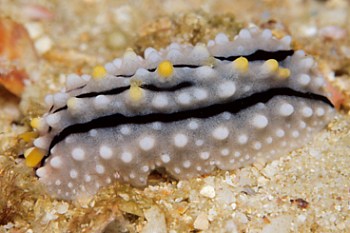
Hi Bill,
I shot this picture at Cavern Point, Mergui Archipelago, Andaman Sea, Myanmar on Feb. 17, 2003. The slug was about 3cm long and about 8 meters deep. I was just about to label the slide "Phyllidia elegans" when I read your messages about Phyllidia alyta. I compared it to the images on the Sea Slug Forum and the many P. elegans slides in my files and concluded that it looks more like Phyllidia alyta. What do you think? I also photographed a "typical" P. elegans in the same area.
Best regards,
Mary Jane
divepng@yahoo.com
Adams, M.J., 2003 (Apr 3) Phyllidia alyta from Myanmar. [Message in] Sea Slug Forum. Australian Museum, Sydney. Available from http://www.seaslugforum.net/find/9517Thanks Mary Jane,
Your animal certainly fits the description of P. alyta.
Best wishes,
Bill Rudman
Re: Phyllidia elegans from the Maldives
March 25, 2003
From: Erwin Koehler
Hi Bill,
I think Orhan's animal is Phyllidia alyta.
Erwin
Erwin@medslugs.de
Dear Erwin,
I think you're right. I onviously haven't got a mindset for this species yet. In Orhan's animal the tubercles are isolated rather than raised on ridges, and most of them are yellow-tipped, rather than just the inner ones, but otherwise it fits. On looking through earlier postings on the P. elegans page I see one of yours from the Maldives is probably a juvenile of P. alyta as well.
Best wishes,
Bill Rudman
Phyllidia elegans from the Maldives
March 23, 2003
From: Orhan Aytur
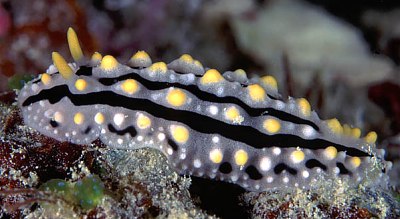
Bill,
Here is a photo of a Phyllidia sp. Having read the descriptions of both, I am still not sure if it is Phyllidia varicosa or Phyllidia coelestis?
Date: January 2002
Location: Fesdu Wreck, Ari Atoll, Maldive Islands
Depth: 20-24m
Cheers,
Orhan
aytur@ee.bilkent.edu.tr
Aytur, O., 2003 (Mar 23) Phyllidia elegans from the Maldives. [Message in] Sea Slug Forum. Australian Museum, Sydney. Available from http://www.seaslugforum.net/find/9370Note added March 25 2003: This is probably a juvenile P. alyta.
Dear Orhan,
This is a species of Phyllidia but it is Phyllidia elegans.
Best wishes,
Bill Rudman
Phyllidia alyta from Reunion Island
November 12, 2002
From: Marina Poddubetskaia
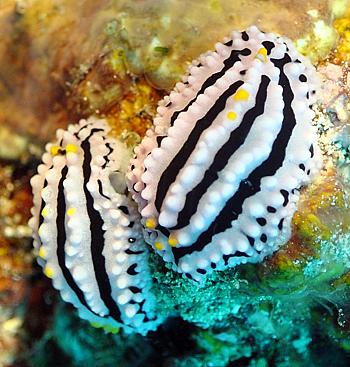
Dear Bill,
Here are some shots of Phyllidia alyta. The ventral view (it is the upper animal of the first photo, taken in a tank) shows well the black median line of the foot, characteristic of this species.
Upper Right: 2 animals mating? St-Leu, Reunion Island, Indian Ocean. Site: Maison Verte. Depth: 13m. Size: 25-30mm. October 06, 2002. Lower Left: ventral view of larger animal in upper right photo.
Lower Right): Location: St-Leu, Reunion. Island, Indian Ocean. Site: Eboulis Reef. Depth: 14m. Size: 45-50mm. October 10, 2002
Photos: Marina Poddubetskaia - Nembro website
Best wishes,
Marina.
nembro@nembro.info

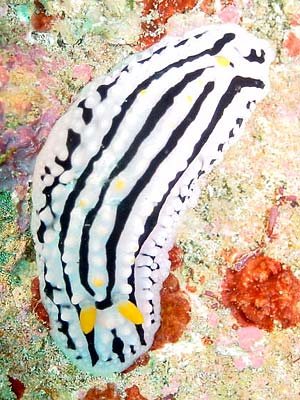
Thanks Marina,
This is another of the interesting Indian Ocean phyllidiids we still need to learn more about. It has interesting similarities in colour to both P. varicosa and P. elegans, both species which also have a black median line on the sole of the foot.
Best wishes,
Bill Rudman
Phyllidia alyta from the Maldives
December 18, 1999
From: Erwin Koehler
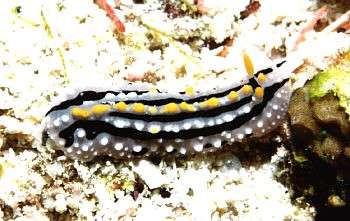
Bill,
I have rescanned the photo which was identified by Nathalie Yonow as
Phyllidia alyta, here it is.
Maldives, Ellaidhoo Is., divesite "Ellaidhoo Thila", size 2 cm, depth 17m, Nov. 18, 1996
Erwin
Medslugs.Koehler@t-online.de
Koehler, E., 1999 (Dec 18) Phyllidia alyta from the Maldives. [Message in] Sea Slug Forum. Australian Museum, Sydney. Available from http://www.seaslugforum.net/find/1588Thanks Erwin,
This animal fits Nathalie's description exactly. I suspect larger specimens may develop yellow-capped tubercles.
Bill Rudman.
Phyllidia alyta? from the Maldives
December 16, 1999
From: Erwin Koehler


Bill,
Here are two more photos from the Maldives:
UPPER: size 44 mm, depth 14 m, Bandos Is., divesite "Banana Reef",
date Oct. 28, 1999
LOWER: size 34 mm, depth 12 m, Olhahali Is., divesite "The Wall",
date Oct. 31, 1999
A similar looking specimen was identified by Nathalie Yonow as Phyllidia alyta Yonow, 1996.
I have no description and do not know if this is a 'good' species.
Erwin
Medslugs.Koehler@t-online.de
Koehler, E., 1999 (Dec 16) Phyllidia alyta? from the Maldives. [Message in] Sea Slug Forum. Australian Museum, Sydney. Available from http://www.seaslugforum.net/find/1564Dear Erwin,
Yes I think these are Phyllidia alyta. It seems to be a distinctive species although the yellow capped tubercles in the two inner rows may be more common in larger specimens, like yours, than Nathalie Yonow suggests in her description.
Best wishes,
Bill Rudman.
Phyllidia elegans from the Maldives
November 21, 1999
From: Erwin Koehler
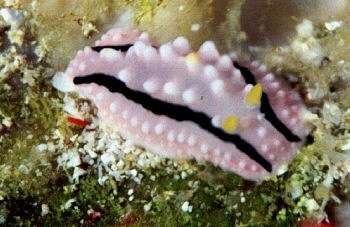
Dear Bill,
Here is the next Phyllidiid from the Maldives, Olhahali Is., divesite
"Olhahali Caves", Nov. 01, 1999, depth 27m, size 19mm
Thanks,
Erwin
Medslugs.Koehler@t-online.de
Koehler, e., 1999 (Nov 21) Phyllidia elegans from the Maldives. [Message in] Sea Slug Forum. Australian Museum, Sydney. Available from http://www.seaslugforum.net/find/1534Note added March 24 2003: This is probably a juvenile P. alyta
Dear Erwin,
I'm pretty sure that this is a juvenile Phyllidia elegans. From the yellow rhinophores and small rhinotubercle behind each rhinophore, it is clearly a Phyllidia, and the arrangement of the dorsal tubercles and colour are fairly characteristic of that species.
Bill Rudman.
